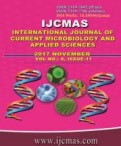


 National Academy of Agricultural Sciences (NAAS)
National Academy of Agricultural Sciences (NAAS)

|
PRINT ISSN : 2319-7692
Online ISSN : 2319-7706 Issues : 12 per year Publisher : Excellent Publishers Email : editorijcmas@gmail.com / submit@ijcmas.com Editor-in-chief: Dr.M.Prakash Index Copernicus ICV 2018: 95.39 NAAS RATING 2020: 5.38 |
Sixty BLSB affected maize samples were collected from three districts and pathogen was isolated and identified based on morphological, cultural and sclerotial characters using standard descriptions of IMI. Light microscopic studies revealed that all the isolates of R. solani f. sp. sasakiiare characteristically branched out at right angle in the distal end of the cell and showed a characteristic constriction at the point of branching. Formation of septum near the point of origin of the branch / adjacent to branch was present in most of the isolates except for isolates RS 44, RS 48, RS 58 and RS 59, where in the septum was slightly away from the origin of branching. The hyphal width of all the 60 isolates varied from 5.05 μm (RS 52) to 7.98 μm (RS 15). Out of 60 maize isolates, eight isolates i.e., RS 7, RS 8, RS 9, RS 10, RS 11, RS 12 RS 16 and RS 26 produced barrel shaped monilliod cells and the remaining isolates produced irregular shaped monilliod cells. Clamp connections were absent in all the isolates, multinucleate and the number of nuclei per cell varied from five to seven in the isolates.
 |
 |
 |
 |
 |